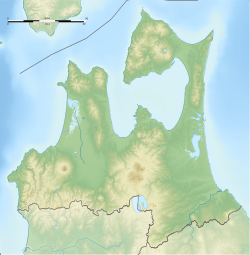Tangotai Kofun
丹後平古墳群 | |
 Shown within Aomori Prefecture | |
| Location | Hachinohe, Aomori, Japan |
|---|---|
| Region | Tōhoku region |
| Coordinates | 40°28′52″N 141°28′1.2″E / 40.48111°N 141.467000°E |
| Type | kofun group |
| Area | 7,000 hectares (17,000 acres) |
| History | |
| Founded | 7th to 9th century AD |
| Site notes | |
| Discovered | 1987 |
| Excavation dates | 1989-1990 |
| Public access | Yes |
The Tangotai Kofun Cluster (丹後平古墳群, Tangotai Kofun-gun) is an archaeological site with a group of circular kofun burial mounds located southwest of the city of Hachinohe in Aomori Prefecture in the northern Tōhoku region of northern Japan. It has been protected by the central government as a National Historic Site since 1999.[1]
Overview[]
The Tangotai site is located on a sloping hill between the Mabechi and Dobashi Rivers, near the Pacific Ocean seacoast. The surrounding area has a high concentration of ruins from the Jōmon through Kofun periods, including the remnants of settlements, graveyards and smaller clusters of kofun as well as a ceremonial burial site for horses.
An estimated 100 tombs were uncovered at the Tangotai site during construction of the “Hachinohe New Town” urban development project in 1987. The tombs are estimated to date from the late 7th century to the mid-9th century, and each consists of a circular mound between four and nine meters in diameter, covering a stone burial chamber consisting of a central pit with a wooden coffin. Numerous grave goods were uncovered from the 29 tombs which were full excavated in 1987-1988, including shards of Haji and Sue pottery, fragments of swords and metal agricultural implements, and thousands of spherical, magatama and tubular beads. Of particular interest was a decorated sword hilt discovered in Tomb 15, with a design similar to those made in Baekje on the Korean Peninsula in the late 6th century. Within Tomb 25 a Wadōkaichin coin minted in 708 AD was discovered. The relics are on display at the Hachinohe City Museum.[1]
The Tagotai Kofun cluster dates from a time when the area was still populated by the Emishi people and was beyond the control of the central Yamato government, yet it indicates the penetration and survival of late Kofun period culture beyond the political bounds of the central government, and hints at possible direct contact between the northern Tōhoku region of Japan and the Korean peninsula in prehistoric times.
In 1999, approximately 7000 hectares of the site received protection by the Japanese government as a National Historic Site.[1] It is located approximately 10 minutes by car from Hachinohe Station.
See also[]
References[]
- ^ Jump up to: a b c "丹後平古墳群". Cultural Heritage Online (in Japanese). Agency for Cultural Affairs. Retrieved 25 December 2016.
External links[]
- Hachinohe City official home page (in Japanese)
- Aomori Prefectural government site (in Japanese)
- Hachinohe City Museum (in Japanese)
- Hachinohe
- Kofun
- Archaeological sites in Japan
- History of Aomori Prefecture
- Historic Sites of Japan

